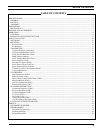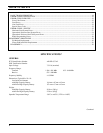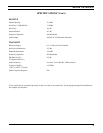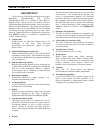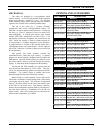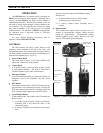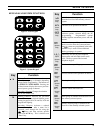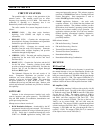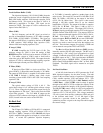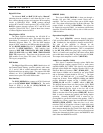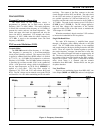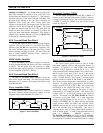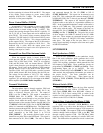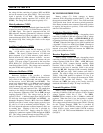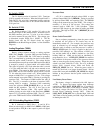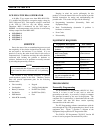
AE/LZB 119 1902 R1A
11
Local Oscillator Buffer (V450)
The injection frequency (1011.2-1016.2 MHz) from the
synthesizer circuit is applied to the base of Local Oscillator
(LO) NPN buffer transistor V450 through capacitor C450
and inductor L450. This signal at the input of V450 is 0
dBM and is amplified to +4 dBm. This signal can be
metered at TP450. The output of V450 is connected to the
input of mixer Z402 (Pin 1).
Mixer (Z402)
The LO frequency and the RF signal are mixed to
provide an Intermediate Frequency of 76.2 MHz (example:
1011.2 MHz - 935.851 MHz = 76.2 MHz). This signal on
the output of Z450 (Pin 4) is applied to the base of IF AMP
1 NPN transistor V500 through filter capacitor C505,
inductor L500 and coupling capacitor C504.
IF Amp 1 (V500)
IF AMP 1 amplifies the 76.2 IF signal +15 dB. The
collector voltage for V500 is from the emitter of LO
BUFFER amplifier V450 and can be metered at TP500 (3.8
V). The emitter voltage of V500 is used as feed back to
control the gain of RF amplifier V400. The output from the
collector of V500 is connected through coupling capacitor
C502 to the input of band pass Filter Z500 (Pin 4).
IF Filter (Z500)
IF band pass Filter Z500 is a 4-pole crystal filter. The
gain of Z500 is -3 dB and the center frequency is 76.2 MHz.
The output of Z500 (Pin 6) is coupled to the emitter circuit
of IF AMP 2 through a limiting zener diode circuit
consisting of zener diodes V502-1 and V502-2 and coupling
capacitor C508.
IF Amp 2 (V501)
The typical emitter voltage of V501 is 0.8 V. The
typical base voltage is 1.6V and the typical collector voltage
is 3.1 V. These voltage levels produce the proper bias for an
input impedance of 250 ohms. This in turn loads the Z500
crystal filter properly. The 76.2 MHz IF output on the
collector of V501 connects to the input of a 450 kHz IF chip
(N551) located in the rear section of the LPE-200.
Rx Back End
IF Chip (N551)
The IF input (76.2 MHz) to IF Chip N551 is connected
through coupling capacitor C550 and inductor L550 to
N551 Pin 1, (RF+). Internal to N551 (DIANE), this input
signal is amplified and applied to an input of a second mixer
circuit. A second LO synthesizer injection frequency
of 76.2 MHz is internally applied to another input of the
mixer circuit. This results in a second IF of 450 kHz (76.65
MHz -76.2 MHz = 450 kHz) on the output of the mixer
(N551, Pin 20, Mixer Out). This signal is then routed
through a 450 kHz ceramic filter to set the channel
bandwidth to 12.5 kHz. The output of the filter is routed to
N551, Pin 18, IF In1. This input (-3 dB) to N551 is
amplified and sent two places. The output (N551, Pin 16,
IF Out 1) signal goes through capacitor C553 to the input of
450 kHz Ceramic Filter Z550, Pin 2. The output of Z550 on
Pin 1 is connected through capacitor C552 to N551, Pin 14,
IF In2. This input to N551 is further amplified and
balanced outputs, RxIF and RxIF_B, are sent to HILLARY
(D701). These two lines, one positive and the other
negative, are used to cancel out any noise that might get on
the line. These balance outputs are typically +3 dBm and
can be metered at test points TP551 and TP552.
The Receiver Signal Strength Indicator (RSSI) circuitry
internally monitors the RF signal strength. The RF level is
represented by a DC voltage level proportional to signal
strength. Feedback resistors R554 and R561 set the gain of
the RSSI output on Pin 7. This signal becomes the FAST
RSSI signal going to DEBBIE (D601). Feedback resistor
R554 connects from the RSSI output on Pin 7 to Pin 8, RSSI
Feedback. The RSSI signal can be metered at test point
TP550.
2nd Local Oscillator
A 2nd LO circuit internal to N551 generates the 76.65
MHz injection frequency for the mixer circuit. The tank
circuit for this oscillator consists of capacitors C556 through
C560, variable capacitor V550 and inductor L551. This
tank circuit connects to N551, Pin 3 (OSC Emitter) and Pin
4 (OSC Base). A LO_VCTRL control voltage is applied
through resistor R555 to V550 to adjust the capacity of the
circuit and maintain the integrity of the injection frequency.
The LO_VCTRL control voltage is a DC level generated in
CHERYL and filtered by resistors R225 and R226 and
capacitors C217, C218 and C219. This voltage (nominally
2.6 volts) comes from auxiliary synthesizer N204 and goes
to the oscillator tank circuit. A +12 dB signal is then
returned to a prescaler circuit in the synthesizer. The
synthesizer provides a signal to the loop filter which outputs
the control voltage.



